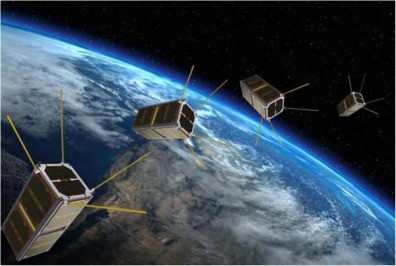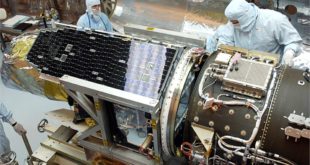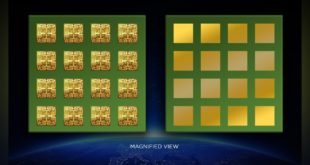Substantially more spectrum bandwidth is available at the Ka band than at the Ku band and other lower frequencies. For example, Ku band allocation is around 2GHz for uplink and 1.3GHz for downlink with actual contiguous bandwidth allocation of less than 0.5GHz per satellite. In comparison, the Ka band SATCOM has a bandwidth of 3.5GHz for both uplink and downlink.
With the wider spectrum availability at the Ka band, higher traffic throughput can be supported. Full motion video for example, has been identified as a key driver in the demand for bandwidth that can be realised by Ka band satellites . In addition, as the Ka band has commercial and military bands adjacent to each other, commercial services can also complement the military band’s capacity.
Ka band satellites feature narrow spot beams (0.5° to 1.5° at 3dB beam width) which support greater frequency reuse in geographically isolated spots. With larger allocation and frequency reuse capabilities, using the Ka band translates to at least a 1 to 2 order magnitude increase in transponder throughput, therefore reducing leasing cost per unit bandwidth.
At higher frequencies, wavelengths are smaller, allowing proportionally smaller, lighter weight and probably less expensive terminals to be realised. The reduction of physical dimensions therefore allows Ka band SATCOM to be made available for new markets such as manpacks and mobile platforms. The use of more focused and narrow Ka band spot beams provides higher equivalent isotropic radiated power (EIRP), signal gain (G/T) and therefore better signal link quality or higher data rates for these smaller terminals.
With wider Ka band bandwidth, better inherent anti-interference properties can be achieved (e.g. frequency hopping or direct sequence spread spectrum). With Ka band transponder sizes of 125MHz or more over 54MHz at Ku band, the additional interference margin with twice the spreading can be improved by at least 3dB.
KA Band Challenges
With the introduction of smaller mobile terminals for Ka band SATCOM, more stringent link requirements will need to be met. The design challenges are as follows:
Meeting Adjacent Satellite Interference Regulations
The regulatory bodies governing satellite communications include the International Telecommunication Union (ITU) and the Federal Communications Commission. With the high density of satellites in orbit and many more Ka band satellites planned for launch, adjacent satellite interference (ASI) will be a key concern. Satellite terminals that wish to transmit must meet the emission regulations. ASI is more challenging for small terminals where the antenna side lobe powers are large with respect to their main lobes, thereby limiting the maximum power they are allowed to transmit.
When these terminals are on the move, allowable emissions are constrained further as the mechanical antenna pointing accuracy experienced during shock and vibration needs to be accounted for during movement through land, various sea states or air turbulence.
Development of low noise transistors operating in the 20 GHz band and high power transistors operating in the 30 GHz band have influenced the development of low cost earth terminals. Space qualified higher efficiency traveling-wave tubes (TWTAs) and ASICs development have improved the processing power. Improved satellite bus designs with efficient solar arrays and higher efficiency electric propulsion methods resulted in cost effective launch vehicles.
Large Rain Attenuation
The SATCOM link that passes through the atmosphere is degraded by rain, fog, cloud, ice, snow and hail. The biggest
challenge in using the Ka band is the high rain attenuation compared with the Ku band and higher rainfall rates in
the tropics. Since the electromagnetic wave absorption component is increased at Ka band, the amount of attenuation
per unit length is also increased. Additional margin is needed to ensure high system availability or tradeoff in link availability. However, adding an additional margin may be impractical for remote terminals with small antenna
and low power amplifier that operates in high rainfall regions.
For example, collected rain statistics in Singapore generated by Leong and Foo (2007) show a higher rain rate than ITU specifications (International Telecommunications Union –Radiocommunications Sector [ITU-R], 2012). This results in a downlink rain loss of 12dB at the Ka band versus 2.6dB at the Ku band to achieve 99% link availability. In addition to higher attenuation, the rain fade rate at the Ka band will be very much higher than at the Ku band. The high rain fade rate will impact the operation of mitigation measures such as ACM algorithms built into the satellite modem.
Mitigation Techniques
Degradations in link quality can be further mitigated by employing three main techniques.
Hub Site Diversity
Site diversity is a fade mitigation measure that involves two or more hub terminals set up to transmit or receive the signal in real time by using an algorithm to choose the least amount of link degradation among all the hub sites at any one instance. When one hub experiences rain and detects that the link may be cut, the algorithm calls for a switchover to the other hub where there are clear skies.
For site diversity to be useful, there are two main considerations. First, hub sites must be sufficiently separated to achieve the required diversity gain or diversity improvement factor. It is shown that diversity gain improves with distance but the gain tapers off at distances more than 11km as it can be treated as a single site fade event . Second, when a site diversity decision is made, the downtime incurred from the hub switchover and the predicted duration of rain outage must both be taken into account. However, hub diversity increases the complexity and the resulting cost of implementation..
Adaptive Coding and Modulation
In ACM, the modulation and coding (MODCOD) of the carrier is altered within the modem in step sizes to increase the survivability of the transmission link. By decreasing the data rate, the signal to noise ratio required for a lower MODCOD is reduced and therefore the carrier becomes more resilient to rain fade. To support a varying data rate transmission during dynamic rain conditions, the video codec running in the application layer should allow a seamless reduction in video quality or resolution to ensure that the recipient is able to receive it. In other words, by adjusting the MODCOD, it is possible to optimise the trade-off between performance and survivability. Applications therefore need to be designed and tested accordingly to take full advantage of the ACM capability. ACM typically provides 15dB of margin across the full range of MODCODs.
Automatic Uplink Power Control
Automatic Uplink Power Control (AUPC) is implemented by increasing carrier power at the transmit end to ensure link
survivability. When a rain fade event is encountered, more power is drawn from the high power amplifier (HPA) to maintain the carrier to noise ratio. Due to the need for additional equipment, AUPC is usually employed only at larger hub stations since the smaller remote terminals’ HPA may already be operating with negligible backoff during clear sky. AUPC at hub stations typically provide 15dB of power control margin.
Design analysis and optimization
Taking into consideration space segment parameters; ground segment mitigation techniques that improve the link quality; environment factors that decrease the link quality significantly; and the increased use of high bandwidth demand video application, a more stringent design analysis approach for link budget calculations is required. The approach will also require a sensitivity analysis, where various trade-offs between operational parameters (e.g. desired link availability for control and mission links), ground segment (e.g. power amplifier ratings and antenna sizes) and space segment (e.g. transponder power and bandwidth) can be analysed and optimised.
Through these trade-off analyses, the feasibility of using the Ka band to support mission critical military aeronautical, maritime and land SATCOM operations can be determined.
It is recommended to start the satellite network design by first identifying the design boundaries – which are the most
constraining factor(s) and which are the parameters that are within and outside of the designers’ control. The typical
constraints are as follows:
Satellites
Usually, the area of operations will define the choice of satellites. If two or more satellites are able to provide the required
coverage, then parameters such as the available power and bandwidth on the transponder, receiver G/T, saturation points of the receivers and saturation flux density (SFD) can be used for the trade-off analysis. The linearity of the transponders is also an indicator of their performance. The more linear they are, the lower the intermodulation noise relative to the carrier will be produced, and therefore the better the output signal which can be achieved
Remote Terminals and Hub
Constraints for remote terminals include the infrastructure or platform they will be hosted in. If the terminals are to be used on the move, the platform will very likely limit the antenna size/weight, position, minimum/maximum elevation angles and/or power amplifier size. If the hub has been implemented, its fixed infrastructure such as antenna size and power amplifier size may be constraining factors.
Transmit power back-off (reduction in the transmit power level) and intermodulation noise should be catered for if multiple frequency carriers are transmitted from a common power amplifier. Losses due to cables and interconnectors as well as inaccuracies in antenna pointing should also be taken into account. Besides these technical parameters, the satellite network designer should also take market availability of the products into consideration.
Communication Links
a) Outbound Link – The outbound link is the overall communications link from the hub to the terminal. It consists of
the hub uplink and the terminal downlink. The outbound link is generally engineered so that the terminal downlink dominates performance. Since the hub services many terminals, it is generally cost effective to make the hub antenna large enough to provide extra transmit power margin on the hub uplink.
b) Inbound Link – The inbound link is the overall communications link from the terminal to the hub. It consists of the terminal uplink and the hub downlink. The inbound link is also generally engineered so that the terminal uplink dominates performance, since the large hub antenna provides extra receive gain on the hub downlink.
c) MODCOD Scheme – The choice of MODCOD is related to the signal to noise ratio required by the modem to demodulate the signal successfully as well as the carrier bandwidth required. These parameters are usually referenced from the modem specifications. The available transmit power or the receiver sensitivity may limit the choice of MODCOD scheme.
Operational Inputs
The operational inputs consist of the information exchange requirements, data rates and link availability required for
the mission. Depending on the application and mission, the end user may have minimum data rate and link availability
requirements. These would then be set as design targets and inputs to the link budget analysis. They impact the satellite
transponder resources directly such as power and bandwidth required to support the link.
Sensitivity Analysis
With numerous link budget parameters, sensitivity analysis is needed to determine the critical trade-offs between size,
power, bandwidth and link availability
 International Defense Security & Technology Your trusted Source for News, Research and Analysis
International Defense Security & Technology Your trusted Source for News, Research and Analysis


